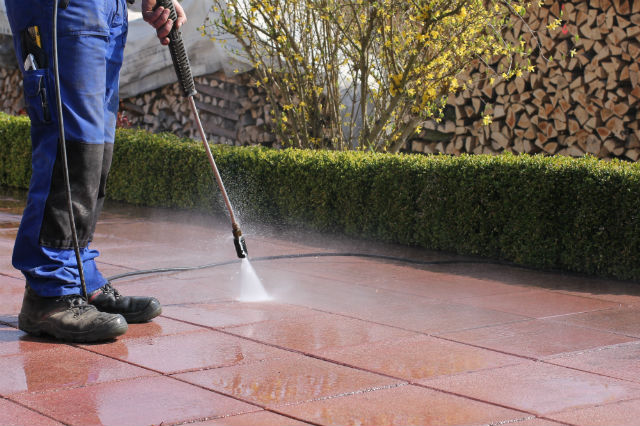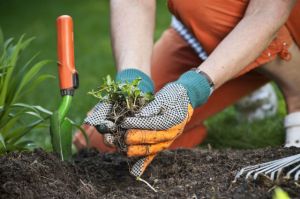So, it’s time to clean your home’s exterior. The task may seem daunting, but the good news is there are several safe and effective ways to get the outside of your home looking brand-new in no time.
Preparation is key
Choose a warm, dry day with little to no wind for the job. Next, make sure all windows and doors are closed tight. Seal doors and windows with plastic or duct tape if you’re worried about leakage.
Place duct tape and plastic sheeting over vents, electrical outlets and outdoor light fixtures. Cover plants and shrubs. Clear away any lawn furniture that may be close to the house. Also, make sure to keep children and pets inside.
Treat tough stains by hand
Look the house over for any stains. Most stains can be removed by hand with soap, water and a sturdy scrub brush. Some of the most common stains are caused by mildew. These can be removed with a mix of oxygen bleach and dishwashing liquid. For each gallon of water, use one-quarter pound oxygen bleach powder and one-eighth cup of dishwashing liquid.
Use a scrub brush and wear a mask to avoid inhaling mildew spores. As when handling any kind of bleach, wear rubber gloves. If you don’t want to make your own, most hardware stores carry a slew of mildew and mold removers.
Over time, masonry and concrete can form efflorescence, a crystalline salt deposit caused by exposure to moisture. You can remove efflorescence with a strong, dry brush and a diluted solution of water and vinegar. There are also a host of commercial cleaners on the market to treat and remove efflorescence.
Rust can be removed with a good scrubbing. You can treat the area with baking soda, then give it a scrub with a wet brush. Go ahead and use sandpaper on stubborn rust stains, but be sure to wear a mask to avoid inhaling rust particles. The area may require a new coat of paint when you’re finished. You can also buy rust-removal products in stores.
Use a garden hose
You can also buy a siding cleaning kit. Many come with nozzle attachments for your garden hose. Use a scrub brush to remove any excess dirt or grime from siding and pretreat any trouble spots with cleaner.
Aim the hose at a 45-degree downward angle and apply cleaner from the bottom to the top of siding to avoid streaking. Then, rinse from top to bottom. Clean one section at a time.
Cleaning kits will often include wands, brushes, extendable handles and containers to fill with cleaner. Some come pre-filled with cleaner. A long-handle scrub brush can do wonders. You can also attach a brush extension to the end of a garden hose to reach those hard-to-get-to places. Always avoid power lines.

A good power cleaning
When the job calls for heavy artillery, you may choose to use a pressure washer. These can be bought or rented.
Size matters when it comes to pressure-washer nozzles. The smaller the nozzle size, the narrower the target area and the stronger the spray stream. The average exterior cleaning requires a 40-degree nozzle, which provides a safe and gentle cleaning. Test the washer out on a small section first.
To use, move the wand in a steady, sweeping motion. Stand about 10 feet away and slowly come in closer as you gauge the cleaning force of the washer. Do not use the wand closer than 2 feet away from the surface. Aim at a downward angle. Apply detergent from the bottom to the top and let it sit for five to 10 minutes. Then rinse, moving from the top to the bottom.
There are many different power-cleaning detergents on the market. Make sure to get the right one for your type of home.
Words of caution
Pressure washers are powerful tools. When used incorrectly, they can damage property and cause injury. Avoid spraying underneath siding or into gaps, which can cause water damage. And be sure to repair or replace any damaged siding before washing. Make certain to wear safety goggles.
It is best to avoid using power washers on exteriors such as stucco, brick or wood shingles. Remember to never direct a pressure washer at windows or another human being. In fact, a power washer can break the surface of the skin. (Did we mention kids and pets should stay inside?)
If using an electric power washer, keep the connections dry and don’t handle the plug when your hands are wet. Do not use a gas-powered washer indoors or without proper ventilation. And, don’t power wash a home covered in lead paint.
If you have a large home, a multi-story home or feel the job is more than you can handle, call a professional.
When is the last time you cleaned your home’s exterior? Do you DIY or leave it to the pros? Tell us in the comments.
One Thought on “Tips for Cleaning Your Home’s Exterior”
Leave A Comment
Comments are subject to moderation and may or may not be published at the editor’s discretion. Only comments that are relevant to the article and add value to the Your AAA community will be considered. Comments may be edited for clarity and length.

















I usually hire someone because I don’t climb latters anymore.